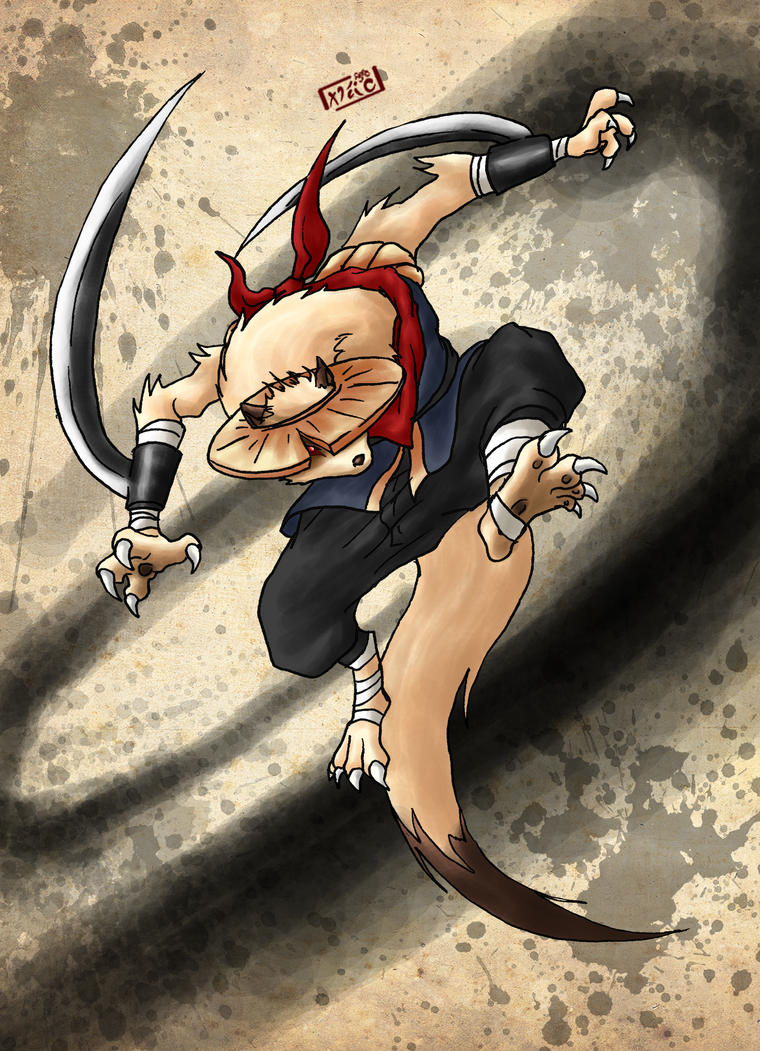Greetings, reader!
The legendary creatures I've spoken about so far have been spread across a wide array of time. Some, like El Chupacabra, have only appeared in recent history. Others, such as the vampire, have appeared in lore for centuries. The Wendigo, while an ancient creature, mostly disappeared from lore a hundred years ago.
For today's post, I'd like to focus on a creature who first appeared in Japanese literature several centuries ago, during the Edo period. It also has a long oral tradition. Though belief in this legend has largely faded away, there are still rural areas, particularly in northeastern Japan, which believe in them. Let's take a look at the Kama-itachi!
Also sometimes spelled Kamaitachi, these creatures are sickle weasels. Yep, that's right - sickle weasels. I know I pranked people with the Drop Bear last week, so let me hasten to assure you: These are a real legend, and have long been believed to exist. For those who don't know, a sickle is not just a silver coin in Harry Potter. It's also a small, curved blade used for harvesting grains - think of it as a miniature scythe. The "kama" part of the name stems from a Japanese variation of a sickle, which has also commonly seen use as a weapon.
And itachi...well, itachi means weasel. Japanese folklore lumps spirits, demons, and monsters under the term yokai, referring to things mysterious, otherworldly, and inhuman. While not all weasels are yokai, there is a long tradition of weasel spirits. Some legends make them out to be mischief makers, like the gods Hermes or Susano. They enjoy pranks, but are usually harmless. Others paint the itachi as a more grim creature. They are harbingers of doom, ill omens that bring death and devastation in their wake.
So what do you get when you combine the two? The Kama-itachi is a weasel creature whose long claws resemble sickles. Its fur is said to be dense and prickly, like that of a hedgehog. Their barking cries echo through the night. They travel upon the wind, and in some cases can even control it. In fact, in some regions of Japan they are known as Kamakaze, meaning "sickle wind" (not to be confused with "kamikaze", the "divine wind" immortalized by suicide bombers).
Depending on the region of Japan, Kama-itachi are said to travel alone or in groups of three. They attack in three strikes. The first knocks its victim to the ground; the second makes a series of slices into the victim's flesh, using its razor sharp claws; the third applies a healing salve, keeping the wounds from bleeding. This is all done in the blink of an eye. It happens so fast that the victim is unable to see the Kama-itachi.
Why do they do this? No one knows. They don't drink the blood, don't steal anything from the victim. Perhaps they merely enjoy knocking people on their butts and laughing at them. I don't know the answer, so here: Have a cute picture to distract you!
There are numerous theories as to what causes the phenomenon associated with Kama-itachi. The two I've seen most often explain that the legends stem largely from areas with strong winds and intense cold. The strange cuts inflicted by the Kama-itachi, which do not bleed, but sting and take days to heal, are said to be caused by the weather. One explanation says that the skin cracks open due to the cold, but does not bleed. Another says that it is caused by small but powerful whirlwinds. Someone out for a walk could be bowled over by a whirlwind; leaves and debris caught in the wind would cause slices similar to papercuts, which don't bleed very much, but do sting.
While this seems like a more logical explanation than the Kama-itachi, I find that I rather prefer the mischievous sickle weasels.
Though they are mostly relegated to the past, the Kama-itachi have made their mark on modern pop culture. They have inspired songs, been the name for bands, and have found their way into modern anime and manga. If you're alright with lots of blood and decapitations, here's a terrifying look at what can happen when a Kama-itachi turns evil. A lot of artwork and stories also anthropomorphize Kama-itachi, giving them clothing and making their sickle claws blades instead. As someone who grew up reading the Redwall series, I very much enjoy this trend.
I hope you've enjoyed this look at the Kama-itachi! See you next week.

:origin()/pre00/6fdb/th/pre/i/2010/123/2/0/dark_kamaitachi_by_luketheripper.jpg)


I enjoyed this read! Thank you for shedding some light on this not very well known creature :)
ReplyDelete